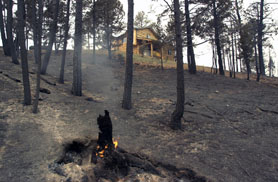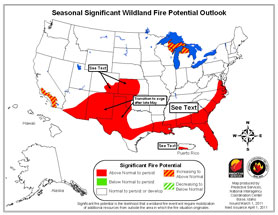
Focus on Fire Safety: Wildfire

Preventative fire safety measures saved this home from a wildfire.
More and more people are making their homes in woodland settings, rural areas, or remote mountain sites. There, residents enjoy the beauty of the environment but face the very real danger of wildfire. Wildfires often begin unnoticed. They can be ignited by the careless tossing of a cigarette, an unattended campfire, or from natural causes like lightning. They spread quickly igniting brush, trees, and homes.
Each year fire burns millions of acres of woodland across the United States.
We can better live with the land by learning about the natural areas we inhabit and what we can do to reduce our risk of loss if wildfire occurs. Homes that survive almost always do so because their owners had prepared for the eventuality of fire. In a wildfire, every second counts!
At the beginning of each wildfire season, the National Interagency Fire Center (NIFC) releases important themes to educate the public on the dangers of wildfire. The 2011 National Fire Season themes are:
1. Safety of the public and firefighters is the top consideration in fire and aviation management.
- Firefighters always make safety their top concern.
- No structure, or natural or cultural resource, is worth taking an unneeded risk.
- Structures can be rebuilt and natural resources generally come back in time. A life cannot be replaced.
2. Firefighters count on you to do your part.
Thousands of communities are located in fire-prone areas. Residents must take action to adapt their communities to fire. These actions will protect their homes and improve the safety of the public and firefighters.
When preparing your property to withstand a wildfire, it's useful to think in terms of zones and consider the area as far as 200 feet from your home. In some cases this may require working with neighbors or other land owners, too.

Click drawing above to enlarge
Zone 1: Home Ignition Zone
The most critical area is your home ignition zone, which includes your home itself and the landscaping within 30 feet. Remember: windblown embers or firebrands can ignite a home while leaving the surrounding vegetation untouched or only charred. Some tips to better protect this zone include:
- Clear pine needles or other woody debris from rain gutters and off the roof.
- Clear all vegetation and debris from under decks and touching the foundation.
- Be sure all eaves and attic vents are screened with a small, ½-inch screen.
- Move stacks of firewood away from the structure.
- Keep vegetation in this area trimmed low, well-irrigated, and free of dead material and spaced apart to prevent a continuous path of fuel to your home.
Zone 2: Defensible Space Zone
This is the second most critical zone and includes the area from 30 to 100 feet from your home.
- Remove dead and dying grass, shrubs, and trees.
- Reduce the density of vegetation and ladder fuels by thinning and keeping them free of dead material.
- Replace hazardous vegetation with less flammable, irrigated landscaping, including lawn or low growing ground cover and flowering plants.
Zone 3: Wildland Fuel Reduction Zone
In this zone, from about 100 feet and beyond, remove dense undergrowth and thin out densely-crowded smaller trees. Experts recommend keeping 10 feet of space between trees and shrubs. Mature trees should be limbed up 6 to 10 feet above the ground.
While there are many steps that can be taken to enhance the survivability of your home and property when wildfire occurs, it's important to remember that each step you take, no matter how small, can make a large difference. Multiple steps together can vastly improve the resistance to fire and subsequent losses.
3. Fires are managed in different ways.
Not all fires are managed the same way. Responding to a fire may include using multiple strategies. The response could range from monitoring a fire that is beneficial to the landscape to aggressively putting out a fire that threatens people, homes, or important natural or cultural resources.
Decisions are based on:
- safety for the public and firefighters,
- what is threatened by the fire,
- forecasted weather,
- fire behavior, and
- what the fire and land-use plans or objectives are for the area.
Firefighters provide the right response to a fire, for the right reasons, at the right time.
4. Fire seasons are expected to become longer and more difficult.

Click map above to enlarge
We are never really out of fire season. Fires can burn at any time of the year in different parts of the country.
Several reasons contribute to longer fire seasons:
- an abundance of flammable plants and trees,
- climate change, and
- more homes and other buildings in fire-prone areas.
Even though the last two fire seasons have been mild in most of the country, firefighters expect future activity to increase.
5. Teamwork is essential in wildland fire.
Wildland fire knows no boundaries. Local, state, tribal and federal firefighters all work together to manage wildfires. Pooling our strengths and resources helps us to be more effective and keeps our costs down.
Related Publications
Links of Interest






 Focus on Fire Safety: Wildfire Poster
Focus on Fire Safety: Wildfire Poster

